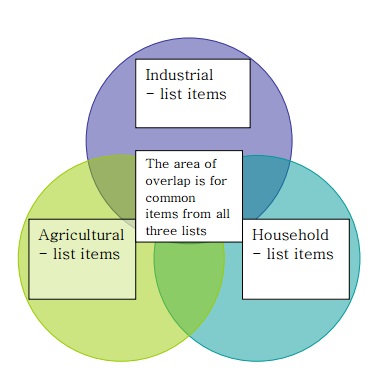Grades 5-12 (Science and Social studies)
Topic: The causes and effects of water pollution.
Time: 60 minutes Space Requirement: Regular classroom Methodology: Jigsaw, cooperative learning, Venn diagram development, poster making
Materials: One copy of the “Types of Pollutants Completed Chart” handout per student, handouts and pictures for each group, poster materials (paper, markers, scissors, glue)
Objectives: Students will be able to list different sources of water pollution and understand which types of pollutants are produced by these sources. They will also be able to describe the effect of water pollution on aquatic life and humans.
For the Teacher: The goal of this lesson is to make students aware that all sectors of society contribute to water pollution. Also, students should be aware of the major types and sources of water pollution. The students may become discouraged after this lesson but reassure them that they can make a difference and that in a future lesson they will be given concrete strategies to improve water pollution.
Directions/Procedure:
Explain to the students that this lesson will be about the sectors of society that generate water pollution and that they will be looking at three general sources: industry, agriculture and domestic. Optional: hand out copies of the “Types of Pollutants Completed Chart” from lesson 2, and review the pollutants that were discussed. (2 min)
On the board write the word “Industry” and with the students, develop a list of pollutants that this sector of society may create. (5 min)
a. May include the following items: gas, oil, plastics, mining, batteries, radioactive material, acid rain, greenhouse gases, warm water and sediment.On the board write the word “Agriculture” and with the students, develop a list of pollutants that this sector of society may create. (5 min)
a. May include the following items: gas, oil, pesticides, herbicides, insecticides, fungicides, automobile exhaust, animal waste, soil erosion, greenhouse gases and sediment.On the board write the word “Household” and with the students, develop a list of pollutants that this sector of society may create. (5 min)
a. May include the following items: gas, oil, automobile exhaust, plastics, batteries, solvents or cleaning products, pesticides, sewage, greenhouse gases, medicines and sediment.From these lists develop a Venn diagram (see below for an example). Each student should copy all three lists and the Venn diagram into his/her notes. (5 min)
Divide the class into six groups and explain the activity to the students: (20 min)
a. Each group will be assigned one type of water pollution and will receive a handout and pictures about that type of pollution. The student handouts are found below, and include information about wastewater pollution, gas production and oil spills, mining, pesticides, marine dumping and industrial wastes). The picture links are also found below. Each group will read the information and make a poster about that type of pollution.
b. The posters must identify the source of pollution, which of the three sectors of society cause the pollution, how common the pollution is, and include pictures of that type of pollution.Each group presents their poster to the rest of the class. The posters are to be put up in the hallway for other students to read and learn about water pollution. (20 min)
a. The presentations should be no more than 3 minutes long.Remind the students to keep filling in their water bottle charts (instructions in lesson 1, will use data in lesson 8).
Evaluation: Students can be assessed on their participation in the group, including the creativity and completeness of the poster, and the quality of the presentation to the class.
Resources:
Sample Venn Diagram (found below)
Student Handouts about Types of Water Pollution (Wastewater Pollution, Gas Production and Oil Spills, Mining, Pesticides, Marine Dumping and Industrial Wastes)
Pollution Picture Links (should be printed out in colour for maximum effect)
Extension Activity: The Safe Drinking Water Foundation has other educational programs that can be taught with this set of lessons. Operation Water Drop examines the chemical contaminants that can be found in water; this program is designed for a science class. Operation Water Flow explores the use of water and where it comes from; this program is designed for a Social studies and Math collaboration. Operation Water Spirit presents a First Nations perspective of water and water issues and is designed for a Native Studies or Social Studies class. Operation Water Health explores common health issues surrounding drinking water in Canada and around the world and is designed for a Health, Science and Social Studies collaboration. To access more information on these and other educational activities visit the Safe Drinking Water Foundation website at www.safewater.org.
Sources and Related Links:
Acid Rain – a SDWF fact sheet
Cost-Benefit Analysis: Treat the Illness or Treat the Water? – a SDWF fact sheet
Emerging Contaminants – a SDWF fact sheet
Groundwater – a SDWF fact sheet
Microplastics Fact Sheet
Oil Fields – a SDWF fact sheet
Oil Spills – a SDWF fact sheet
The Great Lakes – a SDWF fact sheet
Wastewater Treatment – a SDWF fact sheet
Sample Venn Diagram:
Pollution Picture Links:
A) Wastewater Treatment: http://bjulrich.blogspot.ca/
B) Gas Production and Oil Spills: http://celebrating200years.noaa.gov/events/exxonvaldez/valdez_grounded.html
D) Pesticides: https://www.panna.org/blog/its-time-spring-flush-pesticides
E) Marine Dumping: https://nationalgeographic.org/activity/marine-debris
F) Industrial Wastes:
http://www.humanillnesses.com/original/images/hdc_0001_0002_0_img0102.jpg


